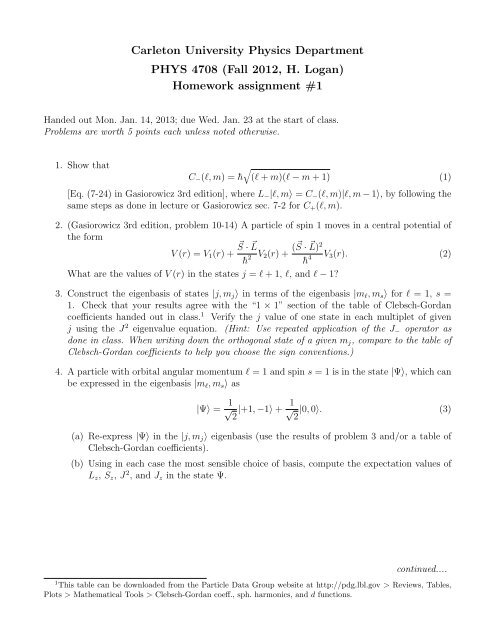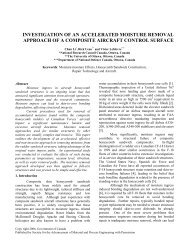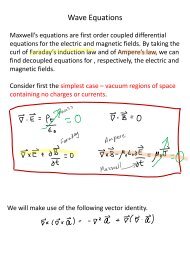Assignment 1 - Department of Physics - Carleton University
Assignment 1 - Department of Physics - Carleton University
Assignment 1 - Department of Physics - Carleton University
Create successful ePaper yourself
Turn your PDF publications into a flip-book with our unique Google optimized e-Paper software.
<strong>Carleton</strong> <strong>University</strong> <strong>Physics</strong> <strong>Department</strong><br />
PHYS 4708 (Fall 2012, H. Logan)<br />
Homework assignment #1<br />
Handed out Mon. Jan. 14, 2013; due Wed. Jan. 23 at the start <strong>of</strong> class.<br />
Problems are worth 5 points each unless noted otherwise.<br />
1. Show that<br />
<br />
C−(ℓ, m) = ¯h (ℓ + m)(ℓ − m + 1) (1)<br />
[Eq. (7-24) in Gasiorowicz 3rd edition], where L−|ℓ, m〉 = C−(ℓ, m)|ℓ, m − 1〉, by following the<br />
same steps as done in lecture or Gasiorowicz sec. 7-2 for C+(ℓ, m).<br />
2. (Gasiorowicz 3rd edition, problem 10-14) A particle <strong>of</strong> spin 1 moves in a central potential <strong>of</strong><br />
the form<br />
V (r) = V1(r) + S · L<br />
¯h 2 V2(r) + ( S · L) 2<br />
¯h 4 V3(r). (2)<br />
What are the values <strong>of</strong> V (r) in the states j = ℓ + 1, ℓ, and ℓ − 1?<br />
3. Construct the eigenbasis <strong>of</strong> states |j, mj〉 in terms <strong>of</strong> the eigenbasis |mℓ, ms〉 for ℓ = 1, s =<br />
1. Check that your results agree with the “1 × 1” section <strong>of</strong> the table <strong>of</strong> Clebsch-Gordan<br />
coefficients handed out in class. 1 Verify the j value <strong>of</strong> one state in each multiplet <strong>of</strong> given<br />
j using the J 2 eigenvalue equation. (Hint: Use repeated application <strong>of</strong> the J− operator as<br />
done in class. When writing down the orthogonal state <strong>of</strong> a given mj, compare to the table <strong>of</strong><br />
Clebsch-Gordan coefficients to help you choose the sign conventions.)<br />
4. A particle with orbital angular momentum ℓ = 1 and spin s = 1 is in the state |Ψ〉, which can<br />
be expressed in the eigenbasis |mℓ, ms〉 as<br />
|Ψ〉 = 1<br />
√ 2 |+1, −1〉 + 1<br />
√ 2 |0, 0〉. (3)<br />
(a) Re-express |Ψ〉 in the |j, mj〉 eigenbasis (use the results <strong>of</strong> problem 3 and/or a table <strong>of</strong><br />
Clebsch-Gordan coefficients).<br />
(b) Using in each case the most sensible choice <strong>of</strong> basis, compute the expectation values <strong>of</strong><br />
Lz, Sz, J 2 , and Jz in the state Ψ.<br />
continued....<br />
1 This table can be downloaded from the Particle Data Group website at http://pdg.lbl.gov > Reviews, Tables,<br />
Plots > Mathematical Tools > Clebsch-Gordan coeff., sph. harmonics, and d functions.
5. Consider again a particle with orbital angular momentum ℓ = 1 and spin s = 1 in the state<br />
|Ψ〉, which can be expressed in the eigenbasis |mℓ, ms〉 as in problem 4 as<br />
|Ψ〉 = 1<br />
√ 2 |+1, −1〉 + 1<br />
√ 2 |0, 0〉. (4)<br />
(a) If you were to measure Lz in this state, what would be the possible outcomes and their<br />
probabilities?<br />
(b) If you were to measure J 2 in this state, what would be the possible outcomes and their<br />
probabilities?<br />
(c) Now imagine that you make the measurement <strong>of</strong> J 2 in this state and get the value 6¯h 2 .<br />
What is the new state <strong>of</strong> the particle after the measurement? Express this new state in<br />
both the |j, mj〉 and the |mℓ, ms〉 eigenbases.<br />
(d) If you were to measure Lz in this new state, what would be the possible outcomes and<br />
their probabilities?






![Assignment 3 [pdf] - Department of Physics - Carleton University](https://img.yumpu.com/19038221/1/190x245/assignment-3-pdf-department-of-physics-carleton-university.jpg?quality=85)

![Assignment 2 [pdf] - Department of Physics - Carleton University](https://img.yumpu.com/19038215/1/190x245/assignment-2-pdf-department-of-physics-carleton-university.jpg?quality=85)



![Assignment 7 [pdf] - Department of Physics - Carleton University](https://img.yumpu.com/19038096/1/190x245/assignment-7-pdf-department-of-physics-carleton-university.jpg?quality=85)

